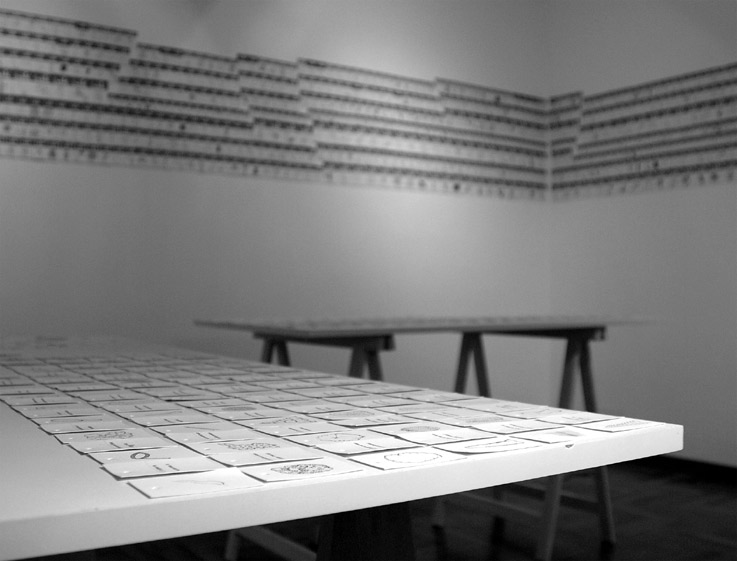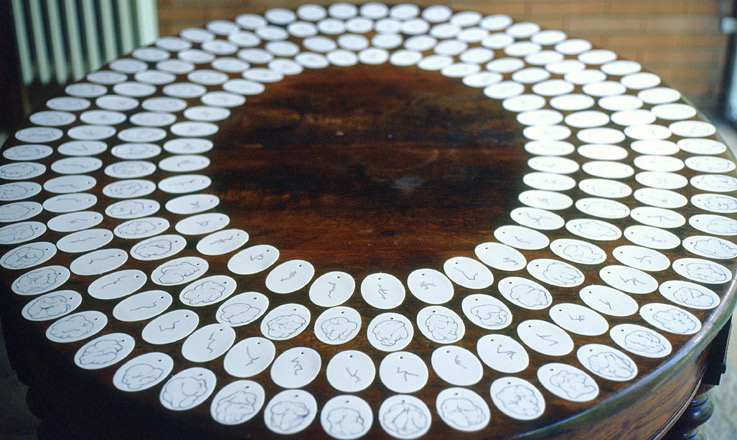‘Systems are descriptions of the world, and the world is not describable without description.’ [1]

The exhibition displays 16,000 small silhouette paintings produced under the same set of rules.
Each painting:
uses the same brush.
is the same size.
uses Ivory black watercolour paint.
is a complete silhouette.
has no gaps or spaces within the painted form.
is numbered.
is not titled.
cannot be repainted.
The unfinished series began in January 2006 as a system of accessing “thoughts” from readings of previously made drawings and sketches covering a thirty-four year time span. The series follows on from other large sequences of drawings and small paintings in displaying a specific role for the small image in contemporary art practice. Some of the series were produced for and during the collaborative Imagine/Image project with the Fondazione Baruchello in Rome.

The adopted method of working looks to emphasise the obsessive nature of producing things as enquiries into “wee thoughts” and how this strategy can grow into a huge work.
Loosely using Picasso’s “Guernica” as a model of scale the project aims to consider the implications of producing a work larger than “Guernica” that also clearly displays the rule based nature of its processes of production. I wanted the construction of scale to be experienced through each specific brush-mark and image as a display of its time of production, as if holding on to momentary thoughts.
I wanted to:
paint moments of thought.
act on intrigue and interest.
display my imaginings as signs.
give significance to thoughts.
display a mass of thinking.
promote a painted language.
propose paintings as sets of serialised instances.
I wanted:
thoughts to become evident.
to go beyond doing enough.
to access my imaginings.
display messages without general meaning.
to emphasise “wee thoughts” as production experiences.
the mass of thoughts to make up a big thought.
Paintings are sets of thinking, serialised instances with each small painting capturing an instance.
The series selects each painting as both outcome and possibility. By conforming to identifiable rule sets personal values are generated, constructed and exchanged from different social events and personal experiences. This involves considerations on shape and style of marks used in describing past experiences through metaphoric forms. This then begins to visually resemble the structure of a conversation, as though visually shaping dialogue around sense and non-sense, certainty and uncertainty.
Each image is a metaphoric acceptance of “being like”, so the product of imagining becomes “being as”.

The denial of artistic freedoms regarding choice of colour, shape of paper, tool of application, method of application seems to promote free possibilities for imagining that allows shifts of thought to investigate intrigue and influence. The tighter the rule, the greater scope for imagining takes place.
Through narrowing possibilities, a platform is established that allows a freedom for imaging, feeling, sensing and reacting to take place.
The system forms the painted language.
Painted language informs the system.
Act of Painting
When I propose the act of painting as a thinking tool I do so with an understanding that formalised approaches to painting offer connection with ones imagination and also the processes of other painters. I am also acutely aware that many these procedures have been well accessed.
Yet, these connections of acted out methods of experience continue to provide opportunities of “drawing things out” from one-self.
Only romantic notions of what painting is or was deny that painting has always been performed to a system that operates in accordance with set rules on the considerations of application to the extent of devising rules to ignore rules.
Paintings have always been systems of communication as “a continual coupling of self-reference and hetero-reference”[2]
So when, “In 1968 the artist and writer Jack Burnham prophesised that, ‘a Systems Aesthetic will become the dominant approach to a maze of socio-technical conditions rooted only in the present…”
Burnham may or may not have been anticipating the death of traditional acts of painting yet his observations clearly called for clarity of strategy in the conception and production of paintings to allow continuing room for the painted act to function and be developed as an operational system.
This attitude does not deny difference in the manner of producing paintings but demands clear responsibility for the painterly actions taken. It places emphasis on the activity as hetero-reference that allows scope for self-reference within the system through simple choice in accordance with rule bases.
We may know how Picasso applied paint, the brushes he used the paint he used etc. and we can try to copy a Picasso, but in our production of it we are exposed to differing thought systems (our thinking, not Picasso’s thoughts) that unquestionably provide the strengths and weaknesses of Picasso’s productions. We cannot reproduce a specific “Picasso painting” even if we try.
Defining rules and strategies of practice allows paintings development through relationships with other social, organisational and practical systems. Painting acknowledges their possibilities and potential to provide a platform for diverse thinking through the act of painting and the construction of a personal aesthetic registered through images. These images can be referenced through the system of which the act of painting only plays a part. My notion of a painting system does not recognise painting as being simply paintings about painting.

My System of Painting
My system allows access to self-referential moments of production as descriptions of thoughts that define these moments for me.
They may be about anything but stand individually within the rules of the series.
The series is a collection of elements related to each by patterns of interest, behaviour and action. These form typical painterly acts more often referred to as style, but who’s style are we borrowing from? What makes it useful?
My series provide frameworks that are able to encompass all of what has been used in art before and influenced my thinking to engage with.
All of this is done through to looking and reflecting on my work and actions, and reacting to what I have noticed, been affected by and intend try out.
Each work is discovered. This may be through a subtle shift or change but each thought and act can be regarded as new play. I need to understand the construction of my rules and how I administer them to play my game. The game is too complex to be built around a solitary act or intention, it is an accumulation of thoughts and actions, built up as sequences that demand responses which in turn develop their own rules, subsets, actions and connections. My actions take me in and out of thoughts and connections that seem to add to and refine a system able to engage in discovery and contradiction, full of sense and non-sense.
When discussing dealing with senses it becomes important that a system of evaluation is also established to gauge success and failure.
However the sheer scale of my series reduces need for decisions on success and failure to be based solely on individual acts.
As each act becomes located metaphorically in action judgements on preference, personal choice and uncertainty are permissible, in fact, vitally important.
The series may seem repetitive or even a constant evidence of self-forgery but the nature of my enquiries supports a belief that subtle shifts are the vital experiences of making. When we cannot understand something clearly we can always take the opportunity to begin it again.
The difficulty of transferring the excitement and possibility of the instant thought into a form that does justice to the original thought is what I form my practice around. The richness of the moment is all too often lost in art. As “wee” thoughts occur when least expected one might not be prepared for the unexpected revelation. Capturing decisions within known practices can constitute discovery and turn it into different readings of reality. Why change a mistake or a hunch? Using the thought that prompts a decision changes the work forever for in an instant it is no longer what it was.
My use of the “wee” thought as the momentary snippet of extreme clarity promotes its vital role in the whole random thinking process. The series makes neuron connectivity relevant as the sparks that stimulate links with other thoughts and on and on.

The elements of my art system can be anything, held together through decisions and implementation of rules and strategies to adopt series of abstracted images. These images interact as art to define my interests and experiences in life and the actions I employ to look into these interests. Some of these acts and images can be appropriated to operate within the series. My art adopts, uses, steals and borrows to allow things to happen.
Images
The significance I attach to each image is important to the system whether recognisable as being so or not. Each image is significant simply by recognition of its act of production.
From the onset a series anticipates producing bodies of work that lend themselves to different sequences of grouping. Some images will emphasise different aspects to display their importance and others their versatility. They will display the scope and potential of thinking through painting, good or bad.
My sense of value regarding importance and significance may be different from others and therefore may not have any importance to anyone else.
There again, it may be that my values are important and therefore can offer significance to others.
By reflecting upon the multitude of small thoughts that influence a practice I recognise the nature of its production to be a vitally important part of my artistic development. By building notions and theories around my decision-making and the forms that inform my practice I aim to continually challenge and promote a role for drawing and painting.
Neil Ferguson, September 2007
=================================
[1]. Hans Dieter Huber, The Artwork as a System and Its Aesthetic Experience, lecture at the Institute of Fine Arts, New York University, at the University of South Florida, Tampa and at the University of Texas at Austin, 1989
[2]. Niklas Luhmann, Art as a Social System, Stanford University Press, 2000, p.11. Where Luhmann discusses that a painting cannot be understood exactly as the painter desires as the audience cannot recognise self-reference but rather, will always be drawn to the hetero reference of style and method as means of communication.
Originally posted by Robert Linsley on 11 November 2007:
ReplyDeleteNeil, I was going to send you an e-mail, but perhaps this is as good a format as any. I wanted to say that I liked your work a lot. It's also a bit daunting in a way. It's close to what I do, but the ease with which you can generate shapes is also implicitly, for me at least, a strong criticism of what I do. It was altogether a shock. Robert